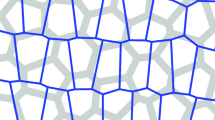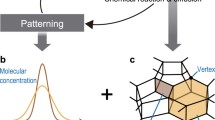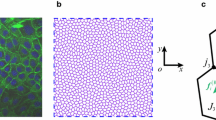Abstract
In biological development, multiple cells cooperate to form tissue morphologies based on their mechanical interactions; namely active force generation and passive viscoelastic response. In particular, the dynamic processes of tissue deformations are governed by the viscous properties of the tissues. These properties are spatially inhomogeneous because they depend on the tissue constituents, such as cytoplasm, cytoskeleton, basement membrane and extracellular matrix. The multicellular mechanics of tissue morphogenesis have been investigated in vertex dynamics models. However, conventional models are applicable only to quasi-static deformation processes, which do not account for tissue viscosities. We propose a vertex dynamics model that simulates the viscosity-dependent dynamic deformation processes during tissue morphogenesis. By incorporating local velocity fields into the governing equation of vertex movements, the model turns Galilean invariant. In addition, the viscous properties of tissue components are newly expressed by formulating friction forces on vertices as functions of the relative velocities among the vertices. The advantages of the proposed model are examined by epithelial growth simulations under the employed condition for quasi-static processes. As a result, the epithelial vesicle simulated by the proposed model is linearly elongated with nearly free stress, while that simulated by the conventional model is undulated with compressive residual stress. Therefore, the proposed model is able to reflect the timescale of deformations by satisfying Galilean invariance. Next, the applicability of the proposed model is assessed in epithelial growth simulations of viscous extracellular materials. In this test, the epithelial vesicles are deformed into tubular shapes by oriented cell divisions, and their morphologies are extremely sensitive to extracellular viscosity. Therefore, the dynamic deformations in the proposed model depend on the viscous properties of tissue components. The proposed model will be useful for simulating dynamic deformation processes of tissue morphogenesis depending on viscous properties of various tissue components.




Similar content being viewed by others
References
Borghi N, James Nelson W (2009) Intercellular adhesion in morphogenesis: molecular and biophysical considerations. Curr Top Dev Biol 89:1–32
Brochard-Wyart F, de Gennes P-G (2003) Unbinding of adhesive vesicles. Comptes Rendus Phys 4:281–287
Cuvelier D, Theory M, Chu YS, Dufour S, Theory JP, Bornens M, Nassoy P, Mahadevan L (2007) The universal dynamics of cell spreading. Curr Biol 17:694–699
Dahmann C, Oates AC, Brand M (2011) Boundary formation and maintenance in tissue development. Nat Rev Genet 12(1):43–55
Davies JA (2005) Mechanisms of morphogenesis: the creation of biological form. Elsevier, Burlington
Davidson L, Keller R (2007) Measuring mechanical properties of embryos and embryonic tissues. Methods Cell Biol 83:425–439
Dewey CF Jr, Bussolari SR, Gimbrone MA Jr, Davies PF (1981) The dynamic response of vascular endothelial cells to fluid shear stress. J Biomech Eng 103(3):177–185
Eiraku M, Takata N, Ishibashi H, Kawada M, Sakakura E, Okuda S, Sekiguchi K, Adachi T, Sasai Y (2011) Self-organizing optic-cup morphogenesis in three-dimensional culture. Nature 472(7341):51–56
Farhadifar R, Röper JC, Aigouy B, Eaton S, Jülicher F (2007) The influence of cell mechanics, cell-cell interactions, and proliferation on epithelial packing. Curr Biol 17(24):2095–2104
Goldstein H, Poole CP, Safko JL (2000) Classical Mechanics, 3rd edn. Addison-Wesley, Boston
Hahn C, Schwartz MA(2009) Mechanotransduction in vascular physiology and atherogenesis. Nat Rev Mol Cell Biol 10(1):53–62
Hardy RJ (1982) Formulas for determining local properties in molecular-dynamics simulations: Shock waves. J Chem Phys 76(1):622–628
He B, Doubrovinski K, Polyakov O, Wieschaus E (2014) Apical constriction drives tissue-scale hydrodynamic flow to mediate cell elongation. Nature. doi:10.1038/nature13070
Heisenberg CP, Tada M, Rauch GJ, Saúde L, Concha ML, Geisler R, Stemple DL, Smith JC, Wilson SW (2000) Silberblick/Wnt11 mediates convergent extension movements during zebrafish gastrulation. Nature 405:76–81
Hochmuth RM(2000) Micropipette aspiration of living cells. J Biomech 33(1):15–22
Honda H, Yamanaka H (1984) A computer simulation of geometrical configurations during cell division. J Theor Biol 106(3):423–435
Honda H, Nagai T, Tanemura M (2008) Two different mechanisms of planar cell intercalation leading to tissue elongation. Dev Dyn 237(7):1826–1836
Honda H, Tanemura M, Nagai T (2004) A three-dimensional vertex dynamics cell model of space-filling polyhedra simulating cell behavior in a cell aggregate. J Theor Biol 226(4):439–453
Ishimoto Y, Morishita Y (submitted) Bubbly vertex dynamics: a dynamical and geometrical model for epithelial tissues with curved cell shapes. arXiv:1405.3839
Lecuit T, Lenne PF (2007) Cell surface mechanics and the control of cell shape, tissue patterns and morphogenesis. Nat Rev Mol Cell Biol 8(8):633–644
Rauzi M, Lenne PF, Lecuit T (2010) Planar polarized actomyosin contractile flows control epithelial junction remodeling. Nature 468(7327):1110–1114
Letizia A, Sotillos S, Campuzano S, Llimargas M (2011) Regulated Crb accumulation controls apical constriction and invagination in Drosophila tracheal cells. J Cell Sci 124(2):240–251
Lye CM, Sanson B (2011) Tension and epithelial morphogenesis in Drosophila early embryos. Curr Top Dev Biol 95:145–187
Mao Y, Tournier AL, Hoppe A, Kester L, Thompson BJ, Tapon N (2013) Differential proliferation rates generate patterns of mechanical tension that orient tissue growth. EMBO J 32(21):2790–2803
Metzger RJ, Klein OD, Martin GR, Krasnow MA (2008) The branching programme of mouse lung development. Nature 453(7196):745–750
Mittal R and Iaccarino G (2005) Immersed boundary methods. Annu Rev Fluid Mech 37:239–261
Odell GM, Oster G, Alberch P, Burnside B (1981) The mechanical basis of morphogenesis. 1. Epithelial folding and invagination. Dev Biol 85(2):446–462
Okuda S, Inoue Y, Eiraku M, Sasai Y, Adachi T (2013a) Reversible network reconnection model for simulating large deformation in dynamic tissue morphogenesis. Biomech Model Mechanobiol 12(4):627–644
Okuda S, Inoue Y, Eiraku M, Sasai Y, Adachi T (2013b) Modeling cell proliferation for simulating three-dimensional tissue morphogenesis based on a reversible network reconnection framework. Biomech Model Mechanobiol 12(5):987–996
Okuda S, Inoue Y, Eiraku M, Sasai Y, Adachi T (2013c) Apical contractility in growing epithelium supports robust maintenance of smooth curvatures against cell-division-induced mechanical disturbance. J Biomech 46(10):1705–1713
Osterfield M, Du X, Schüpbach T, Wieschaus E, Shvartsman SY (2013) Three-dimensional epithelial morphogenesis in the developing Drosophila egg. Dev Cell 24(4):400–410
Rauzi M, Verant P, Lecuit T, Lenne PF (2008) Nature and anisotropy of cortical forces orienting Drosophila tissue morphogenesis. Nat Cell Biol 10(12):1401–1410
Taniguchi K, Maeda R, Ando T, Okumura T, Nakazawa N, Hatori R, Nakamura M, Hozumi S, Fujiwara H, Matsuno K (2011) Chirality in planar cell shape contributes to left-right asymmetric epithelial morphogenesis. Science 333(6040):339–341
Unterberger MJ, Schmoller KM, Wurm C, Bausch AR, Holzapfel GA (2013) Viscoelasticity of cross-linked actin networks: experimental tests, mechanical modeling and finite-element analysis. Acta Biomater 9(7):7343–7353
Park S, Koch D, Cardenas R, Käs J, Shih CK (2005) Cell motility and local viscoelasticity of fibroblasts. Biophys J 89(6):4330–4342
von Dassow M, Davidson LA (2009) Natural variation in embryo mechanics: gastrulation in Xenopus laevis is highly robust to variation in tissue stiffness. Dev Dyn 238(1):2–18
Woolner S, Papalopulu N (2012) Spindle position in symmetric cell divisions during epiboly is controlled by opposing and dynamic apicobasal forces. Dev Cell 22(4):775–787
Acknowledgments
The authors appreciate valuable comments from Dr. Yoshihiro Morishita, Katsuhiko Sato and Yukitaka Ishimoto at the RIKEN Center for Developmental Biology, Japan. This study was supported by JSPS KAKENHI Grant Numbers 25889070.
Author information
Authors and Affiliations
Corresponding author
Additional information
We dedicate this article to the memory of Dr. Yoshiki Sasai, who suddenly passed away on August 5, 2014 at the beginning of our project exploring mechanics in developmental morphogenesis.
Electronic supplementary material
Below is the link to the electronic supplementary material.
Appendix
Appendix
1.1 Balance of friction forces among the vertices of a geometrical element
Friction forces are exerted between multiple bodies moving at different velocities. In the proposed model, viscous frictions are defined at the several vertices comprising each geometrical element.
From Eq. (4), the viscous friction force exerted on the \({i^\text {c}}\)th vertex, represented by \(\varvec{f}^\text {v}_{i^\text {v}}\), is given by
where \(\varvec{v}_{i^\text {v}}\) is the displacement velocity of the \(i^\text {v}\)th vertex, \(\hbox {d} \varvec{r}_{i^\text {v}} / \hbox {d} t\).
To derive the viscous friction force exerted on the \({i^\text {v}}\)th vertex by the \({l^\text {v}}\)th vertex, Eq. (20) is multiplied by the following equation.
where \(\delta _{k^\text {v} l^\text {v}}\) is the Kronecker delta function. The force \(\varvec{f}^\text {v}_{i^\text {v}}\) can now be separated into two forces in terms of \(k^\text {v}=l^\text {v}\) and \(k^\text {v} \ne l^\text {v}\) as follows.
Hence, the viscous friction force \(\varvec{f}^\text {vv}_{i^\text {v} l^\text {v}}\), exerted on the \({i^\text {v}}\)th vertex by the \({l^\text {v}}\)th vertex, is the first term involving \(\delta _{k^\text {v} l^\text {v}}\) in Eq. (22):
According to Eq. (23), \(\varvec{f}^{\text {vv}}_{i^\text {v} l^\text {v}}\) is a linear function of the relative velocity. Therefore, the viscous friction coefficient of the \({i^\text {v}}\)th vertex introduced by the \({l^\text {v}}\)th vertex given by \(\eta ^\text {vv}_{i^\text {v} l^\text {v}}\) can be written as
The viscous friction coefficients between the \({i^\text {v}}\)th and the \({l^\text {v}}\)th vertices are then related by
Thus, the viscous friction coefficients are symmetric for any pair of vertices.
Using Eq. (23), the sum of viscous friction forces between a pair of vertices is given by
Thus, the viscous friction forces exerted between any two vertices are balanced.
1.2 Galilean invariance of vertex dynamics model
The following theoretical analysis clarifies whether the vertex dynamics in the proposed and conventional models are invariant under the Galilean transformation. The Galilean transformation is
where \(\varvec{V}\) is an arbitrary velocity vector. Substituting Eq. (27) in Eq. (1), we retrieve Eq. (1). Hence, the proposed model is invariant under the Galilean transformation.
The conventional models (Honda et al. 2004; Okuda et al. 2013a, b, c) neglect the local velocity vectors (i.e., \(\varvec{v}^\text {f}_i=\varvec{0}\) in Eq. (1)). Hence, the movement of the \(i^\text {v}\)th vertex is given by
Substituting Eq. (27) into Eq. (28), we obtain
Compared to Eq. (29), Eq. (28) contains an additional force term \(-\eta ^\text {v}_0 \varvec{V}\). Thus, the conventional models described by Eq. (28) violate Galilean invariance unless the additional force can be ignored.
1.3 Cell rearrangement and division behaviors
Cell rearrangement is expressed by reconnecting local network patterns using the reversible network reconnection (RNR) model (Okuda et al. 2013a). The RNR model generates continuous cell rearrangements that are geometrically, energetically and topologically reversible. Cell proliferation is accomplished by a cell proliferation model (Okuda et al. 2013b), in which cells divide (increase their number) and grow (increase their volume). In particular, cell division is simulated by dividing a single polyhedron along a plane.
When the number of molecules in the \({i^\text {c}}\)th cell \(n^\text {cm}_{i^\text {c}}\) increases to \(\left( 4/3 \right) n^\text {cm}_{0}\), the \({i^\text {c}}\)th cell divides into two daughter cells. The dividing plane is regulated to be normal to the plane of the cell sheet and globally oriented along the growth direction, as shown in Fig. 2a. The normal direction of the cell plane is specified as a vector pointing from the center of an outside polygonal face of each cell to the center of that cell. Details of the cell division are similar to those of the global regulation used in our previous study (Okuda et al. 2013c).
1.4 Numerical implementation
Equations (1) and (28) were numerically time-integrated using the Euler method with a time step of \(\Delta t\). Vertex velocities in Eq. (1) were iteratively solved by convergent calculations. Convergence was reached when the mean residual error was below the threshold \(RE_\text {th}\), as follows.
Local network patterns were reconnected when each edge included in a local pattern turned shorter than a specified threshold \(\Delta l_\text {th}\). The reconnection rule was trialed at each edge and each trigonal face during each time interval \(\Delta t_r\). Numerical parameters are listed in Table 2.
All experiments were performed on a cluster computer comprising 12 nodes with 2.9 GHz Intel Xeon dual processors and 64 GB RAM (Visual Technology Co., Japan).
1.5 Stress tensor estimation
To analyze the deformation mechanics within the tissues, stress tensors were estimated from the locations and forces of vertices according to (Hardy 1982).
The stress tensor \(\varvec{\sigma }_{\text {v}}\) over the whole epithelial vesicle is estimated as
where the scalar \(v_{\text {t}}\) is the volume of the epithelial vesicle, and \(\sum _{j^\text {v}}^\text {vertex}\) denotes the summation overall vertices. The stress tensor \(\varvec{\sigma }_{i^\text {c}}\) at the \({i^\text {c}}\)th cell is estimated as
where the scalar \(v_{i^\text {c}}\) is the volume of the \(i^\text {v}\)th cell, and \(\sum _{j^\text {v}}^\text {vertex}\) sums overall vertices. Vector \(\varvec{f}^\text {cv}_{i^\text {c} j^\text {v}}\) denotes the interior force of the \({i^\text {c}}\)th cell exerted on the \(j^\text {v}\)th vertex:
Rights and permissions
About this article
Cite this article
Okuda, S., Inoue, Y., Eiraku, M. et al. Vertex dynamics simulations of viscosity-dependent deformation during tissue morphogenesis. Biomech Model Mechanobiol 14, 413–425 (2015). https://doi.org/10.1007/s10237-014-0613-5
Received:
Accepted:
Published:
Issue Date:
DOI: https://doi.org/10.1007/s10237-014-0613-5




